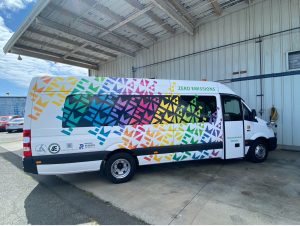HONOLULU – The Hawaiʻi Department of Transportation (HDOT), in collaboration with the University of Hawaiʻi at Mānoa, will launch its first autonomous electric passenger shuttle, taking another meaningful step toward meeting the state’s sustainability and resiliency goals.
The vehicle will be showcased at the WASHTO (Western Association of State Highway and Transportation Officials) 2023 annual meeting, June 4 to 7, to highlight the state’s successful efforts to build a resilient future by transitioning all-petroleum fleet vehicles to electric vehicles with the necessary charging infrastructure, which will include chargers, solar, battery storage, microgrids and more.
The state-of-the-art AV Star All-Electric Autonomous Min-E Bus can hold 14 passengers. It is also ADA-compliant and can accommodate 10 passengers and two passengers in wheelchairs. The vehicle is also equipped with the Perrone Robotics TONY (To Navigate to You) autonomous system and meets all Federal Motor Vehicle Safety Standards.
This will be the first program to take advantage of Hawaiʻi’s Autonomous Vehicle Testing law. Vehicles equipped with automated systems can ultimately lessen the number and severity of crashes, saving lives and reducing serious injuries. As the state moves toward electrifying its motor vehicle fleet by 2035, this pilot program will also provide HDOT with valuable information regarding all-electric fleet operations.
The fleet vehicle is expected to serve as part of the Rainbow Shuttle service to transport students and staff around the Mānoa campus in Phase I, and then provide customized mobility-on-demand services in East Kapolei communities in Phase II. In addition, the UH Mānoa College of Engineering is collecting data to develop an analysis on the vehicles for HDOT.
Enabled by vehicle automation and connectivity enhancement, this pilot autonomous shuttle bus project provides first-hand experience and invaluable understanding of near-future transportation system operations. It will help the state better prepare for the upcoming vehicle-infrastructure-autonomy integrations, and large-scale autonomous vehicle deployments in Hawaiʻi. This project is well aligned with state’s strategic development goals and advances HDOT to the frontier of emerging technology innovations.
Comparing this vehicle to a comparable gas-powered transit van, this electric vehicle has the capacity to save more than 660 gallons of gas per year (~$3,133 savings/year in cost of fuel at $4.60/gallon) and decrease carbon dioxide by 13,021 pounds/year.
Remaining on course to successfully implement electrification across the islands, HDOT is pleased to partner with UH and make significant strides to meet the state’s sustainability goals.
This project was made possible through the state’s electric vehicle and charging infrastructure as a service with Sustainability Partners, which enables HDOT and other interested state and county agencies to procure electric vehicles (EVs) and charging infrastructure on a usage cost basis.
State and county agencies interested in learning more about the service contract or benefits of EV conversions can visit the HDOT website for cost comparisons and contact information.
Photos of Shuttle:
###

